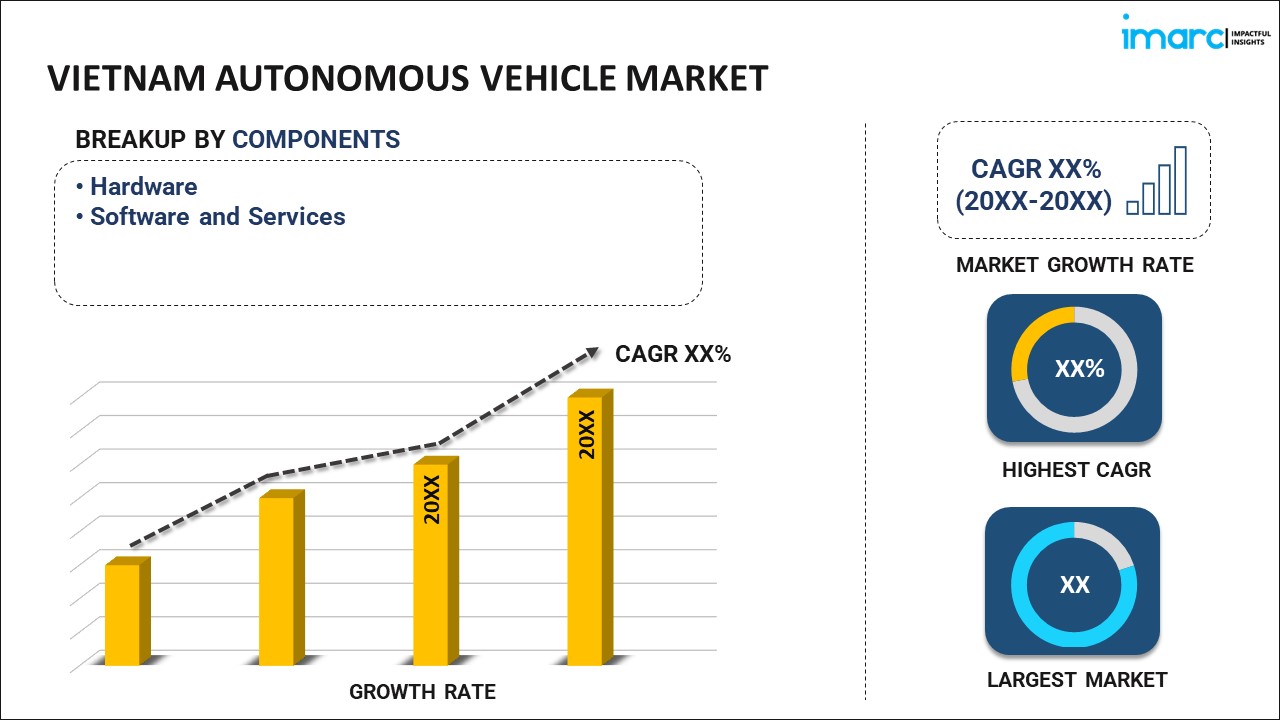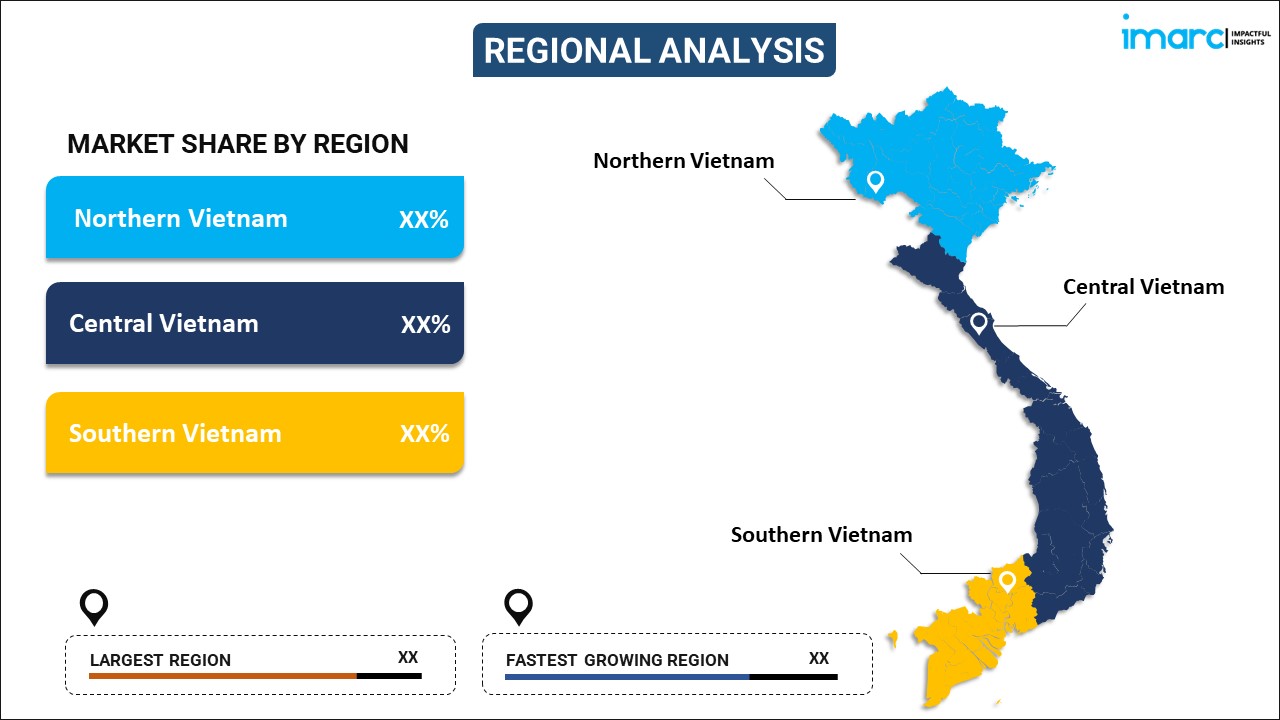
Vietnam Autonomous Vehicle Market Report by Component (Hardware, Software and Services), Level of Automation (Level 3, Level 4, Level 5), Application (Transportation and Logistics, Military and Defense), and Region 2025-2033
Market Overview:
Vietnam autonomous vehicle market size is projected to exhibit a growth rate (CAGR) of 26.7% during 2025-2033. The rising road safety concerns among the masses, development of sophisticated artificial intelligence (AI) algorithms and machine learning (ML) models, and increasing need for sustainability and reducing greenhouse gas emissions represent some of the key factors driving the market.
|
Report Attribute
|
Key Statistics
|
|---|---|
|
Base Year
|
2024 |
|
Forecast Years
|
2025-2033 |
|
Historical Years
|
2019-2024
|
| Market Growth Rate (2025-2033) | 26.7% |
Autonomous vehicles, also known as self-driving cars or driverless cars, are equipped with advanced technology and sensors that allow them to navigate and operate without human intervention. They are installed with a range of sensors, including cameras, radar, lidar, and ultrasonic sensors, which provide real-time data about the environment of automobiles. They rely on artificial intelligence (AI) algorithms to process sensor data and make driving decisions, such as steering, braking, and accelerating. They can communicate with each other and with infrastructure to enhance safety and traffic management. They prioritize safety, often including redundant systems, emergency braking, and collision avoidance technology. They use high-definition (HD) maps and global positioning system (GPS) to determine their position and navigate routes accurately. They can optimize driving patterns, reduce traffic congestion, and improve fuel efficiency, leading to reduced emissions and improved traffic flow. They can provide transportation options to senior citizens and individuals with disabilities. They allow drivers to use their travel time more productively, such as working or relaxing. They are widely used for personal transportation, offering convenience and safety to individuals and families. Besides this, as they can drop passengers and park themselves, reducing the need for large parking areas in urban cities, the demand for autonomous vehicles is increasing in Vietnam.
Vietnam Autonomous Vehicle Market Trends:
At present, increasing cases of road accidents and rising safety concerns among the masses are driving the demand for autonomous vehicles in Vietnam. Autonomous vehicles are equipped with advanced collision avoidance systems that can detect and respond to potential hazards faster than human drivers. Apart from this, continuous technological advancements in the automotive industry are offering a favorable market outlook in Vietnam. The development of sophisticated AI algorithms and machine learning (ML) models is improving the decision-making capabilities of autonomous vehicles. These systems can process vast amounts of data and adapt to changing road conditions. Along with this, several automobile companies are investing in mapping technologies to support autonomous vehicle operations. Furthermore, the rising need for sustainability and reducing greenhouse gas emissions is driving the adoption of autonomous electric vehicles (AEVs) in the country. Autonomous vehicle fleets can be managed more efficiently, reducing congestion and overall energy consumption. Moreover, increasing collaborations and partnerships among automotive manufacturers, technology companies, and startups are influencing the market positively in Vietnam. These partnerships accelerate innovation and bring together diverse expertise. Besides this, the expanding applications of autonomous vehicles in commercial sectors like delivery services are bolstering the market growth in the country. The logistics industry is increasingly utilizing autonomous trucks for long-haul transportation. In addition, several car manufacturers, tech companies, and venture capitalists in Vietnam are investing in research and development (R&D) activities to accelerate the development of autonomous vehicle technology.
Vietnam Autonomous Vehicle Market Segmentation:
IMARC Group provides an analysis of the key trends in each segment of the market, along with forecasts at the country level for 2025-2033. Our report has categorized the market based on component, level of automation, and application.
Component Insights:

- Hardware
- Software and Services
The report has provided a detailed breakup and analysis of the market based on the component. This includes hardware and software and services.
Level of Automation Insights:
- Level 3
- Level 4
- Level 5
A detailed breakup and analysis of the market based on the level of automation have also been provided in the report. This includes level 3, level 4, and level 5.
Application Insights:
- Transportation and Logistics
- Military and Defense
The report has provided a detailed breakup and analysis of the market based on the application. This includes transportation and logistics and military and defense.
Regional Insights:

- Northern Vietnam
- Central Vietnam
- Southern Vietnam
The report has also provided a comprehensive analysis of all the major regional markets, which include Northern Vietnam, Central Vietnam, and Southern Vietnam.
Competitive Landscape:
The market research report has also provided a comprehensive analysis of the competitive landscape. Competitive analysis such as market structure, key player positioning, top winning strategies, competitive dashboard, and company evaluation quadrant has been covered in the report. Also, detailed profiles of all major companies have been provided.
Vietnam Autonomous Vehicle Market Report Coverage:
| Report Features | Details |
|---|---|
| Base Year of the Analysis | 2024 |
| Historical Period | 2019-2024 |
| Forecast Period | 2025-2033 |
| Units | Million USD |
| Scope of the Report | Exploration of Historical Trends and Market Outlook, Industry Catalysts and Challenges, Segment-Wise Historical and Future Market Assessment:
|
| Components Covered | Hardware, Software and Services |
| Levels of Automation Covered | Level 3, Level 4, Level 5 |
| Applications Covered | Transportation and Logistics, Military and Defense |
| Regions Covered | Northern Vietnam, Central Vietnam, Southern Vietnam |
| Customization Scope | 10% Free Customization |
| Post-Sale Analyst Support | 10-12 Weeks |
| Delivery Format | PDF and Excel through Email (We can also provide the editable version of the report in PPT/Word format on special request) |
Key Questions Answered in This Report:
- How has the Vietnam autonomous vehicle market performed so far and how will it perform in the coming years?
- What has been the impact of COVID-19 on the Vietnam autonomous vehicle market?
- What is the breakup of the Vietnam autonomous vehicle market on the basis of component?
- What is the breakup of the Vietnam autonomous vehicle market on the basis of level of automation?
- What is the breakup of the Vietnam autonomous vehicle market on the basis of application?
- What are the various stages in the value chain of the Vietnam autonomous vehicle market?
- What are the key driving factors and challenges in the Vietnam autonomous vehicle?
- What is the structure of the Vietnam autonomous vehicle market and who are the key players?
- What is the degree of competition in the Vietnam autonomous vehicle market?
Key Benefits for Stakeholders:
- IMARC’s industry report offers a comprehensive quantitative analysis of various market segments, historical and current market trends, market forecasts, and dynamics of the Vietnam autonomous vehicle market from 2019-2033.
- The research report provides the latest information on the market drivers, challenges, and opportunities in the Vietnam autonomous vehicle market.
- Porter's five forces analysis assist stakeholders in assessing the impact of new entrants, competitive rivalry, supplier power, buyer power, and the threat of substitution. It helps stakeholders to analyze the level of competition within the Vietnam autonomous vehicle industry and its attractiveness.
- Competitive landscape allows stakeholders to understand their competitive environment and provides an insight into the current positions of key players in the market.
Need more help?
- Speak to our experienced analysts for insights on the current market scenarios.
- Include additional segments and countries to customize the report as per your requirement.
- Gain an unparalleled competitive advantage in your domain by understanding how to utilize the report and positively impacting your operations and revenue.
- For further assistance, please connect with our analysts.
 Inquire Before Buying
Inquire Before Buying
 Speak to an Analyst
Speak to an Analyst
 Request Brochure
Request Brochure
 Request Customization
Request Customization




.webp)




.webp)












